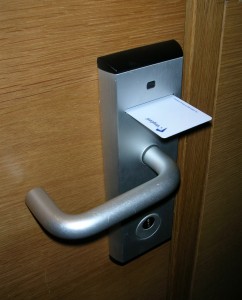 We have an entire department dedicated to electromechanical solutions. And, while you may not have realized how much wireless locks have progressed throughout the years, the rate at which they’re excelling was enough for us to say, “Guys, we really need an entire department dedicated to electromechanical locks. Like ASAP.”
We have an entire department dedicated to electromechanical solutions. And, while you may not have realized how much wireless locks have progressed throughout the years, the rate at which they’re excelling was enough for us to say, “Guys, we really need an entire department dedicated to electromechanical locks. Like ASAP.”
(I like to imagine that those were the exact words used. “Like ASAP.”)
Despite how popular these locks have become, we still get hit with a lot of questions regarding whether or not electronic access control is something that would benefit one particular company or another, specifically wireless access control. With as fast as this product is moving, I thought it would be a good time to brush up on some wireless lock information.
Wireless Locks and Their Hubs
Wireless locks work hand-in-hand with a device called a hub. This is similar to a WiFi router, but imagine if the router was designed to pair with a certain device on a specific frequency. That’s a hub.
In general, any facility with more than eight wireless locks will require more than one hub. You’ll need to have a general idea of how many locks you want and then go from there to determine how many hubs you’ll need for your facility.
With wireless locks, you might get a lot of chatter when the lock tries to communicate with the hub. When hubs are located on different frequencies, the amount of chatter will be greatly reduced.
Credentials
With wireless locks you get your choice of credentials you want people who access your facility to use. This can range from badges to codes, and in the future, biometrics will be a more widespread option.
Credentials are stored on a server and when a badge is swiped or a code is entered, the lock then validates the credentials right there on the spot. The server is sometimes referred to as a “control room” so as much as I wanted it to be some top secret room with tons of computers running information, it isn’t happening. A control room is just a server.
Audit Trails
Audit trails are another option that needs to be considered when it comes to wireless locks. Audit trails contain information about who accessed your facility and is stored within the lock. These are especially handy in facilities that house confidential information or if you have a lot of merchandise disappearing.
Wireless locks can sometimes seem overwhelming, but once it’s broken down into different components, it’s much easier to understand. Are you considering wireless locks for your facility? If so, give us a call! We have an entire team in-house that’s ready to answer any questions you might have.
